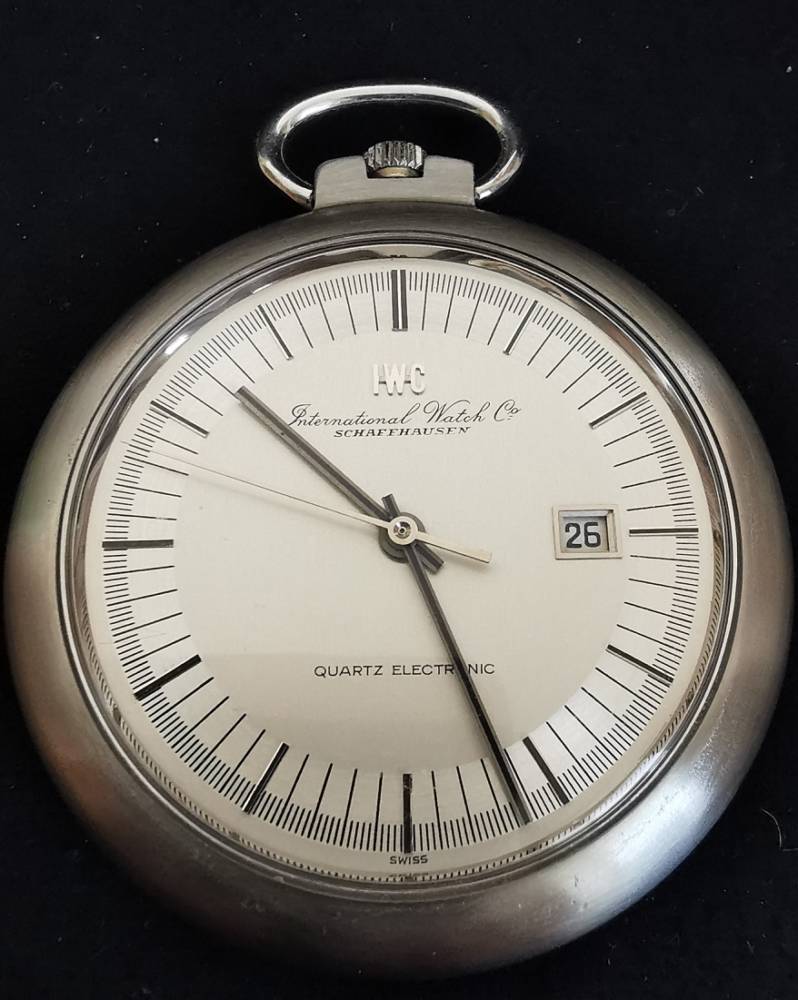As some of you know, I am collecting pocketwatches, IWC only.
Far from saying that my collection is a museum collection but I am proud to
have found some nice and rare pieces over time.
Some of the pocketwatches are common, easy to find on the market, sometimes in
better condition than mine, but some I have are gems.
So in these crazy times, as the museum in Schaffhausen is closed, why not open
one here on the forum.
As long as the museum is closed, I will post here daily a pocketwatch from my
collection.
I hope I don't run out of pieces before the virus is beaten. Fingers crossed
for all of us.
I will post them in a random order, with some comments, feel free to join.
Keep safe all.
DAY 29 : Cal 2002, Quartz electronic, also known as Beta 21
What is this ? Is it human ? Can it fly ? Is it an UFO ?

No, it is just another pocketwatch in my collection.
I have shown some rare and very rare old pocketwatces so far, but this one was
sold August 1, 1974 in Zurich.
A younger pocketwatch but one seldom seen.
It has a steel case that expresses perfectly the novelty, the historic
importance of the caliber. It is the Quartz electronic, with the caliber Beta
21, called the IWC cal 2001 ( and later Beta 22 and IWC cal 2002 ).
The watches came is steel and gold cases.
The cal Beta 21 was developped by Centre Electronique Horloger laboratories in
Neuchatel (CEH)
The Centre Electronique Horloger ( CEH ) was an organization founded
to produce electronic watches in Switzerland.
The CEH was a consortium of 20 Swiss watch manufacturers, the Centre
Electronique Horloger was founded in 1962 and based in Neuchatel. Foundation
of the CEH was driven by Ebauches SA and the FH. The best-known product of the
CEH was the beta family of quartz watch movements that would enable the Swiss
to compete with Japanese and American quartz watches. The production beta 21
movement was launched in 1970, following prototypes produced from 1967.
More info about that history can be found here
an article by Armin H. Frei, LSMFormer Research Staff Member Centre
Electronique Horloger
You can find Beta 21 movements in Rolex, Patek, Omega,... too.
Watches featuring the Beta 21 calibre movement were only produced for about
five years. When the last ones left the factory they were already obsolete and
far too expensive.
To have an idea of the cost of the wristwatches ( since I haven,'t found the
prices of the pocketwatches ) in 1972
a gold Yacht Club on a strap sold for 1900 DM
a steel Yacht Club on a strap sold for 690 DM
a steel Aquatitmer, ref. 1812, on a strap sold for 655 DM
--and in 1972 this model, Ref. 3070, with strap --get this-- sold for 4675
DM.
Here is a picture from an old catalogues

And here are these on my desk

Some more technical info in a post by Jack Freedman :
IWC caliber: 2001 (CEH BETA 21)
Type of movement: first quartz-movement used by IWC
Production: started 1971
Number of movements built: cal. 2001 = ca. 600 // cal. 2002 = ca. 9600
Movement diameter: 24,30 x 29,00 mm or 10 ¾ x 12 ¾ Paris Lines
Movement height: 7,50 mm
Average lifetime of the battery: max. 20 month
Battery type: 313
Number of functional jewels: 13 artificial jewels
Oscillating frequency: 8'192 Hertz
Adjustment system: trimming potentiometer
Second-hand position: from the centre
Second-hand stop-function: yes
Date-indication: dial-opening at 3 o'clock
This movement has some specials. One is the oscillating frequencywith 8192
Hertz (modern Quartz movements are working wit 32768 Hertz) and the other is
the way how the electronically impulses are made into the moving of the
wheels. The BETA watches uses a tuning-fork-driving-gear, modern quartz-
movement uses a stepping-electro-motor. This is the reason why the second
hands of the watches with the calibre's 2001 and 2002 are sweeping.
The main difference between the calibre 2001 (BETA 21) and 2002 (BETA 22) is
the electronic and the trimmer. There is a third BETA movement named BETA 23
which is not used by IWC in series. This movement also uses the tuning-fork-
driving-gear but it uses a new electronic with a quartz that oscillates with
32768 Hertz. Because these electronic is changeable to the other BETA
movements IWC use the electronic of the BETA 23 at the repairs of the
calibre's 2001 and 2002.
Here are some pictures I borrowed from the internet : the gold case and a pic
of the inside with a view on the calibre.


Back to mine



Here is a little video of the movement of the second hand. You will notice the
difference between this quartz electronic and the jumping second hand of a
modern quartz watch.
www.youtube.com/watch?v=7aww0ntjp3Y
Note : don't mistake the quartz electronic on a dial with the IWC watches with
electronic on the dial, these have the Bulova based tuning fork movement.














